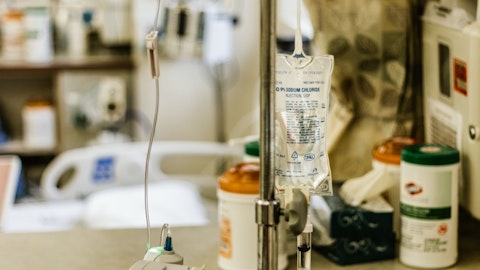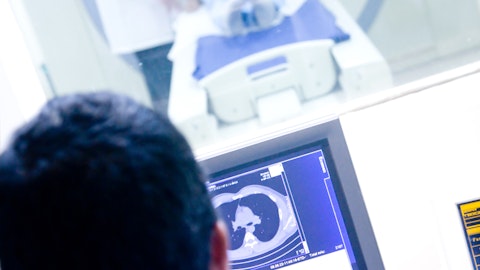NovoCure Limited (NASDAQ:NVCR) Q3 2023 Earnings Call Transcript October 26, 2023
NovoCure Limited beats earnings expectations. Reported EPS is $-0.46, expectations were $-0.52.
Operator: Welcome to the NovoCure Q3 2023 Earnings Conference Call. [Operator Instructions] Please be advised that today’s conference is being recorded. I would now like to hand the conference over to your speaker today, Ingrid Goldberg. Please go ahead.
Ingrid Goldberg: Good morning and thank you for joining us to review NovoCure’s third quarter 2023 performance. I am on the phone this morning with our Executive Chairman, Bill Doyle; our CEO, Asaf Danziger; and our CFO, Ashley Cordova. Other members of our executive leadership team are also on the call and available for Q&A. For your reference, slides accompanying this earnings release can be found on our website, www.novocure.com on our Investor Relations page under Quarterly Reports. Before we start, I would like to remind you that our discussions during this conference call will include forward-looking statements and actual results could differ materially from those projected in these statements. These statements involve a number of risks and uncertainties, some of which are beyond our control and are described from time to time in our SEC filings.
We do not intend to update publicly any forward-looking statement, except as required by law. Where appropriate, we will refer to non-GAAP financial measures to evaluate our business, specifically adjusted EBITDA, a measure of earnings for interest, taxes, depreciation, amortization and share-based compensation. We believe adjusted EBITDA is an important metric as it removes the impact of earnings attributable to our capital structure, tax rate and non-cash items and thus reflects the financial value generated by our business. Reconciliations of non-GAAP to GAAP financial measures are included in our press release, earnings slides and in our Form 8-K filed with the SEC today. These materials can also be accessed in the Investor Relations page of our website.
Following our prepared remarks today, we will open the line for your questions. I will now turn the call over to our Executive Chairman, Bill Doyle.
Bill Doyle: Thank you, Ingrid and good morning. At NovoCure, our mission is to extend survival in some of the most aggressive forms of cancer through the development of our novel therapy, Tumor Treating Fields. This quarter, we made progress on numerous fronts in pursuit of our mission. Before we review the quarter, I would like to address the evolving situation in Israel. NovoCure was founded in Israel. And as we have grown, our Israeli DNA has remained an important part of our culture and identity. We have 260 colleagues in Israel and hundreds of current and former patients who are affected by the terrorism of October 7 and its horrific aftermath. We are living with grief, shock, fear, anger and sorrow. We will do everything in our power to buttress members of the NovoCure family.
Our thoughts and prayers are with everyone affected by these devastating events. Shifting back to our quarterly results. Q3 was a period of continued execution at NovoCure. We finished the period with 3,639 global active patients on therapy and significantly added to the body of clinical data supporting the use of TTFields therapy across multiple cancer indications. We also made meaningful progress on our pipeline, including our next series of clinical trials and product development enhancements. This morning, we will begin with an update of our lung cancer program. We will then discuss our other clinical programs and our commercial business. We will close with a review of third quarter financials. In Q3, we continued to strengthen the foundation of clinical data supporting the use of TTFields therapy especially in our thoracic program.
In August, the results of the Phase 3 LUNAR clinical trial in metastatic non-small cell lung cancer were published in the journal, Lancet Oncology. As a reminder, the LUNAR data showed a statistically significant and clinically meaningful extension in overall survival for patients treated with TTFields therapy and the standard of care, exhibiting 13.2 months median overall survival compared to 9.9 months for patients treated with standard of care alone. The results were more pronounced in patients who received TTFields therapy and an immune checkpoint inhibitor, demonstrating 18.5 months median overall survival compared to 10.8 months in patients treated with an immune checkpoint inhibitor alone. Lancet Oncology is one of the premier clinical oncology research journals.
We are proud to have the LUNAR data published in this prestigious and impactful platform. In addition to the Lancet publication, several key post-hoc analyses of LUNAR were presented at major medical congresses during the third quarter, further illustrating the broad and growing interest in the LUNAR clinical trial. Key among these was an analysis of survival patterns for LUNAR patients with known tumor progression scores presented at the IASLC World Conference on Lung Cancer in September. This analysis showed that patients treated with TTFields and an ICI with TPS scores greater than 1% exhibited a substantially longer median overall survival compared to those patients treated with an immune checkpoint inhibitor alone, 23.6 months compared to 10.5 months.
Further, in patients with low TPS scores between 1% and 49%, median overall survival reached 19 months in the TTFields plus ICI arm versus 9.7 months for treated with an ICI alone. While sample sizes are small, these data support the potential of TTFields to materially extend survival in a large subpopulation of non-small cell lung cancer patients who may not be prime candidates for immune checkpoint inhibitor monotherapy and who could benefit from the addition of TTFields therapy to their pharmacological therapies. The robust extension of survival demonstrated in LUNAR is key to our ongoing efforts to further explore the capabilities of TTFields and immune checkpoint inhibitors for the treatment of non-small cell lung cancer. In October, at the European Society of Medical Oncology Conference, we presented health-related quality of life data from the LUNAR trial.
Consistent with all our previously conducted trials, the use of TTFields in the LUNAR study did not result in an increase in systemic toxicity and did not impact the health-related quality of life of patients in the study. Also in October, at the American Society for Radiation Oncology Annual Meeting, we presented a simulation showing the ability to treat cancerous lung tissue with TTFields regardless of a patient’s body mass index. These analyses underscore the applicability of TTFields to treating metastatic non-small cell lung cancer and the growing interest in the LUNAR dataset within the oncology community. On the regulatory front, our teams are on track to submit the final module of our PMA application to the FDA later this year. This comes on the heels of our completed European CE Mark application last quarter.
The LUNAR trial is an important milestone as it is our first randomized clinical trial demonstrating extended survival in the treatment of cancers of the torso. We are now advancing our plans for our next lung cancer clinical trials. These next LUNAR trials will explore the use of TTFields together with immunotherapies, which showed immense promise in our first LUNAR trial. Success in these trials will allow us to expand the lung cancer patient populations indicated for TTFields therapy. Beyond our thoracic program, we have two randomized Phase 3 clinical trials nearing major milestones. Top line data from the METIS trial is expected late in Q1 2024. METIS is evaluating the use of TTFields therapy to treat brain metastases for non-small cell lung cancer following stereotactic radiosurgery.
And in the second half of 2024, we expect top line data from the PANOVA-3 trial. PANOVA-3 is evaluating the use of TTFields therapy together with nab-paclitaxel and gemcitabine for the first-line treatment of locally advanced pancreatic cancer. In Q3, we also made progress in our PANOVA-4 study, which is exploring the use of TTFields therapy together with atezolizumab for the treatment of metastatic pancreatic cancer. PANOVA-4 enrolled its first patient and is now open and actively recruiting patients. Finally, in the third quarter, we announced the top line results from the INNOVATE-3 trial in platinum-resistant ovarian cancer. INNOVATE-3 did not meet its primary endpoint. Platinum-resistant ovarian cancer is a difficult-to-treat condition.
And while we are disappointed with the top line results of INNOVATE-3, we have gained key learnings for the design of future trials. Most notably, we saw a promising survival trend in patients who entered the trial after failing a single previous line of platinum therapy compared to those enrolled after failing multiple lines of therapy. The benefit observed for women who enrolled in INNOVATE-3 earlier in their cancer therapy journey reinforces our understanding that TTFields therapy is that it’s most effective when used early on and informs our plans for future trials. I’d like to close today by reiterating my enthusiasm for the milestones we have reached this year and for those to come in the near future. With two Phase 3 trial readouts and our launch in non-small cell lung cancer on the docket for 2024, the future is bright for NovoCure and we look forward to the opportunity to treat many more patients suffering from difficult-to-treat cancers in the coming years.

I will now turn to Asaf to discuss our GBM business.
Asaf Danziger: Thank you, Bill. Our GBM business is the core driver of our financial strength, generating $0.5 billion in revenue and free cash flow that are invested in the TTFields platform. We ended the third quarter with a record 3,639 active patients on therapy. We have had a very successful Optune launch in France and have more than 150 French patients on therapy. We have learned many lessons through our French launch. We built our team in the country over the prior 2 years and focused on building awareness of TTFields therapy among French healthcare leaders. Early investment planted the seeds for an efficient and effective therapy rollout and we believe the French launch playbook will serve as a blueprint for future loan success.
In the U.S., we continue to see new activities and dialogues emerge following our commercial reorganization. Teams have improved cross-functional alignment and are synchronized in addressing the key levers contributing to our growth, including patient starts, patient therapy duration and patient usage. All of these inputs are critical to long-term growth in active patients and net revenue. Our teams are focused on increasing awareness of the benefits of TTFields among potential patients and prescribing physicians. In Q3, we finalized our direct-to-consumer campaign, I Power My Life and expect to introduce the campaign to the market next year. We believe direct-to-patient messaging will raise awareness of TTFields therapy and strengthen the demand from patients following diagnosis.
We expect direct-to-consumer engagement will be instrumental to driving greater demand from patients and caregivers. We are also focused on driving awareness among the broader oncology community for treatment of GBM and cancers of the torso. Physician engagement has been strong during recent congresses, especially during the ASTRO earlier this month. Strengthening the foundation of clinical evidence is key to driving greater penetration in our current markets. In July, Dr. Matthew Ballo published a meta-analysis comparing the outcomes reported in 9 studies of over 1,400 GBM patients, where TTFields therapy was added to TMZ after surgery. Dr. Ballo’s analysis of real-world data confirmed the outcome of our Phase 3 EF-14 trial and confirmed the improved outcomes associated with patients using TTFields therapy over 75% of the time.
Real-world analysis of this size reinforced the survival benefit achieved when TTFields therapy is prescribed for GBM and an important tool as we look to reach more patients and physicians. Beyond our efforts to drive demand, we are working to improve ease of use and drive duration of therapy through product development. This month, we launched our next generation arrays in Germany. As a reminder, these arrays leverage new materials and a unique design to improve the patient experience, they are lighter, thinner and more flexible than previous versions, and have the ability to deliver greater intensity to the tumor site without a corresponding increase in hit. We are on track to submit a PMA supplement to the FDA for the new arrays later this year.
Additionally, we are pleased to announce the hiring of our new Chief Medical Officer, who will join us in January. While we are restricted from sharing the candidate’s full details at this time, we are very pleased and look forward to adding his expertise and fresh perspectives to our leadership team. Pritesh Shah will also be transitioning from NovoCure, Pritesh plans to stay on at NovoCure for several quarters as an adviser to ensure a smooth transition to the new CMO and the continued success of our teams. I would like to close by addressing the violent events in Israel. It is difficult to describe the emotional impact of the last few weeks. Many of us, including myself, have lost loved ones to this carnage. And now all of us have family members and friends who served in harm’s way sons and daughters, brothers and sisters, mothers and fathers.
The atrocities of war are horrible, it makes me said that this is our reality today. I hope and pray that the conflict will be resolved swiftly. I will now turn to Ashley to close today’s call.
Ashley Cordova: Thank you, Asaf. The third quarter was a period of consistent execution across multiple verticals. With several clinical readouts, regulatory filings and commercial launches on the horizon, we are investing in the essential infrastructure to ensure we are prepared to fully leverage growth opportunities in the coming years. We generated $127 million in net revenues in the third quarter and ended September with 3,639 active patients on therapy, an increase of 6% from the same period last year. Our successful launch in France continues to be a tailwind as we had a second straight quarter of strong prescription flow and patient starts. The pre-commercial engagement and subsequent commercial execution in France have provided a blueprint, which we will leverage in future country launches.
We collected $4 million in revenue from France this quarter. But as a reminder, it will take several quarters for the collection cycle to reach full reimbursement levels, and France will impact the net revenue per active patient in EMEA during this time. In the U.S., we continue to experience a year-over-year headwind due to the absence of collections from denied or appealed claims. Last year, we collected $15 million from these claims in the third quarter, which have largely been exhausted at this point. Moving forward, we expect our U.S. business to more closely track the key drivers of net revenue, active patient starts, duration of therapy and net revenue per active patients per month. In Germany, our recovery following defined coverage negotiations continued this quarter.
We ended the third quarter with 492 active patients on therapy, a 5% increase from Q3 of last year. This quarter, we saw a decrease in prescriptions as our German team focuses on driving higher quality, more readily-reimbursable prescriptions and increasing pull-through of patient starts and long-term active patient growth. Gross margin for the third quarter was 75%. Over the course of the year, we have invested in expanded patient support capacity in anticipation of treating larger patient populations from new indications and geographic region. As we have shared, product development enhancements, such as our new arrays will impact our gross margin in the near-term. This impact will be felt more acutely in the coming quarters as we roll out the new arrays in our largest market, beginning with Germany this quarter.
We are focused on pursuing opportunities to increase efficiencies and scale within our supply chain and will take the steps needed to balance the impact of these product enhancements, while maintaining a healthy margin. SG&A expenses were $100 million this quarter. We continue to invest tactically to ensure we are quick to capture growth opportunities in the future. This includes investing in commercial capabilities to increase penetration in GBM, pre-commercial activities in non-small cell lung cancer and market access capabilities to reach new patient population. In addition, we have increased spending in IT and supply chain capacity. Research, development and clinical trial costs for the quarter were $54 million. With the conclusion of the LUNAR and INNOVATE-3 trials, our R&D investment is shifting to our next wave of Phase 3 clinical trials.
This includes the LUNAR-2 trial, where we are preparing to engage sites and enroll patients in the coming months. We look forward to updating you on the progress of this and other clinical trials in the coming quarters. Cash and short-term investments totaled $921 million as of September 30, 2023. Our net loss for the third quarter was $49 million or $0.46 per share, and adjusted EBITDA was a negative $29 million. We are in a window of investment in preparation, with new commercial launches on the horizon and the potential of treating much larger patient population. With these growth opportunities approaching, we are committed to investing tactically to align our near-term capital allocation priorities with our long-term strategic vision. Our goal is to balance the capacity investments needed to treat more patients, while preserving our financial strength and ensuring our ability to invest in value-additive opportunities in the future.
I’d like to close today by sharing a story about one of our Optune users, Jovan Knutson. As you may recall, we highlighted Jovan last October. Jovan was diagnosed with GBM in 2021 and began using Optune soon thereafter. As an avid cyclist, she often bikes to her routine visits at the Mayo Clinic, over 100 miles each way. This summer, Jovan set out to tackle an even greater feet, an 850-mile tour of the Upper Midwest. The logistics associated with the tour of this great length can be daunting, with daily checkpoints to reach and supplies to replenish. Jovan worked with our Encompass team to ensure all Optune supplies would be ready and waiting throughout her journey so she could continue her Optune treatment while cycling. Jovan completed her 850-mile tour in August, and we are thankful for the opportunity to support her amazing feat.
Our mission to extend survival in some of the most aggressive forms of cancer is rooted in patients like Jovan. To give the gift of time for patients to be with their loved ones, pursue dreams, and achieve amazing feat by Jovan, I’d like to personally congratulate Jovan and thank her for letting us share her story. With that, I’ll hand it back to the operator for questions.
See also 20 States with the Highest Alcohol and Beer Tax and 10 Best Rugged Smartphones in 2023.
Q&A Session
Follow Novocure Ltd (NASDAQ:NVCR)
Follow Novocure Ltd (NASDAQ:NVCR)
Operator: Thank you. [Operator Instructions] Our first question comes from Jonathan Chang of Leerink Partners. Please proceed.
Jonathan Chang: Hi, guys. Thanks for taking my questions. Can you discuss your pancreatic cancer strategy for Tumor Treating Fields? What’s the rationale behind the PANOVA-4 study and the time lines associated with that? And how should we be thinking about the PANOVA-4 study initiating before the PANOVA-3 readout next year? Thank you.
Bill Doyle: So, good morning, Jonathan, this is Bill. I’ll start and then turn it over to Uri to describe the details of PANOVA-4. But of course, pancreatic cancer is one of the most difficult diagnosis and has proven to be one of the most difficult cancer to treat with many, many failures, of course. Our strategy starts with the fact that we know that we can deliver tumor treating fields to the region of the therapy. Many chemotherapies that depend on the circulatory system can’t even get to the region because of issues with the stromal tissue and differentiation of pressures. So we start there. Further, we start and have built on a very successful Phase 2 trial, where we showed extremely impressive results in a small sample size, for both locally advanced pancreatic cancer and metastatic pancreatic cancer.
In our first PANOVA trial, and I’ll remind everyone, this is a trial that we expect to read out toward the end of next year. We focused on locally advanced pancreatic cancer. And this is the stage of the disease where we can completely encompass the – extended the disease with our Tumor Treating Fields therapy. PANOVA also is a first-line trial. So we start at the time of diagnosis in combination with gemcitabine and nab-paclitaxel. And so we remain very optimistic and enthusiastic about the design of this trial. And we’re preparing for success here in terms of rolling out the therapy to this patient population. So that’s the first element of our pancreatic cancer strategy. And now, let me turn it over to Uri – to describe the results or to – pardon me, not results, but to describe the intent to expand the patient population once we anchor in locally advanced.
Uri Weinberg: Good morning. So the background for opening the PANOVA-4 at this time is that we’re doing our best to integrate lessons learned through our clinical program and our scientific program. And learning from the [indiscernible] study in newly diagnosed GBM patients, and from the LUNAR study results where we have seen an outstanding performance of TTFields when concomitantly used with immune checkpoint inhibitors. We feel that we should not hold off on the next step also in pancreatic cancer, even prior to reading the results of the PANOVA-3 study. So PANOVA-4 is for metastatic disease. It will incorporate atezolizumab concomitant with chemotherapy and TTFields and anti-PDL-1 and will be done in collaboration with Roche for these reasons.
Jonathan Chang: Understood. Thanks for taking my questions.
Operator: Thank you. [Operator Instructions] And our next question comes from Jason Bednar of Piper Sandler. Please proceed. Jason, your line is open. [Operator Instructions] And our next question comes from Lei Huang of Wells Fargo.
Lei Huang: It’s Lei calling in for Larry. Thanks for taking my question. Can you hear me, okay?
Asaf Danziger: We can. Thanks, Lei.
Lei Huang: Thanks. Just – I have a few questions, starting on the lung side. Is there any update on the KEYNOTE-B36 trial on clinicaltrials.gov, there is a completion date for mid-2024. Can you comment on that?
Pritesh Shah: Yes. Lei this is Pritesh. Thank you for that question. We’re very excited to have the trial open, B-36 study is a study that’s a Phase 2 pilot study that’s exploring the use of Tumor Treating Fields in the first-line non-small cell lung cancer with KEYTRUDA. So it’s an important study that will help us understand the benefits of moving Tumor Treating Fields plus an IO up in the first-line setting. So the trial is open and enrolling. One of the aspects of lung cancer that we already know, that it’s a very competitive space from a trial perspective, because of the high unmet need. There are lots of agents and there are lots of trials that are open in this space. So, to get rapid enrollment for a Phase 2 study like this can be a challenge.




